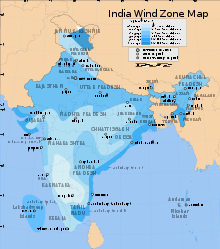Natural disasters in India
 Disaster-prone regions in India. |
 Map showing winds zones, shaded by distribution of average speeds of prevailing winds. |
Natural disasters in India, many of them related to the climate of India, cause massive losses of life and property. Droughts, flash floods, cyclones, avalanches, landslides brought on by torrential rains, and snowstorms pose the greatest threats. A natural disaster might be caused by earthquakes, flooding, volcanic eruption, landslides, hurricanes etc. In order to be classified as a disaster it will have profound environmental effect and/or human loss and frequently incurs financial loss.[1] Other dangers include frequent summer dust storms, which usually track from north to south; they cause extensive property damage in North India[2] and deposit large amounts of dust from arid regions. Hail is also common in parts of India, causing severe damage to standing crops such as rice and wheat.
Landslides and Avalanches
Landslides are very common indeed in the Lower Himalayas. The young age of the region's hills result in labile rock formations, which are susceptible to slippages. Rising population and development pressures, particularly from logging and tourism, cause deforestation. The result is denuded hillsides which exacerbate the severity of landslides; since tree cover impedes the downhill flow of water.[3] Parts of the Western Ghats also suffer from low-intensity landslides. Avalanches occurrences are common in Kashmir, Himachal Pradesh, and Sikkim.
Floods in India
Floods are the most common natural disaster in India. The heavy southwest monsoon rains cause the Brahmaputra and other rivers to distend their banks, often flooding surrounding areas. Though they provide rice paddy farmers with a largely dependable source of natural irrigation and fertilisation, the floods can kill thousands and displace millions. Excess, erratic, or untimely monsoon rainfall may also wash away or otherwise ruin crops.[4][5] Almost all of India is flood-prone, and extreme precipitation events, such as flash floods and torrential rains, have become increasingly common in central India over the past several decades, coinciding with rising temperatures. Meanwhile, the annual precipitation totals have shown a gradual decline, due to a weakening monsoon circulation[6] as a result of the rapid warming in the Indian Ocean[7] and a reduced land-sea temperature difference. This means that there are more extreme rainfall events intermittent with longer dry spells over central India in the recent decades.
Cyclones in India
Intertropical Convergence Zone, may affect thousands of Indians living in the coastal regions. Tropical cyclogenesis is particularly common in the northern reaches of the Indian Ocean in and around the Bay of Bengal. Cyclones bring with them heavy rains, storm surges, and winds that often cut affected areas off from relief and supplies. In the North Indian Ocean Basin, the cyclone season runs from April to December, with peak activity between May and November.[8] Each year, an average of eight storms with sustained wind speeds greater than 63 kilometres per hour (39 mph) form; of these, two strengthen into true tropical cyclones, which have sustained gusts greater than 117 kilometres per hour (73 mph). On average, a major (Category 3 or higher) cyclone develops every other year.[8][9]
During summer, the Bay of Bengal is subject to intense heating, giving rise to humid and unstable air masses that produce cyclones. Many powerful cyclones, including the 1737 Calcutta cyclone, the 1970 Bhola cyclone, the 1991 Bangladesh cyclone and the 1999 Odisha cyclone have led to widespread devastation along parts of the eastern coast of India and neighboring Bangladesh. Widespread death and property destruction are reported every year in exposed coastal states such as Andhra Pradesh, Orissa, Tamil Nadu, and West Bengal. India's western coast, bordering the more placid Arabian Sea, experiences cyclones only rarely; these mainly strike Gujarat and, less frequently, Kerala.
In terms of damage and loss of life, Cyclone 05B, a supercyclone that struck Orissa on 29 October 1999, was the worst in more than a quarter-century. With peak winds of 160 miles per hour (257 km/h), it was the equivalent of a Category 5 hurricane.[10] Almost two million people were left homeless;[11] another 20 million people lives were disrupted by the cyclone.[11] Officially, 9,803 people died from the storm;[10] unofficial estimates place the death toll at over 10,100.[11]
See also
Citations
- ↑ Goswami BN, Venugopal V, Sengupta D, Madhusoodanan MS, Xavier PK (2006). "Increasing trend of extreme rain events over India in a warming environment". Science. 314 (5804): 1442–1445. doi:10.1126/science.1132027. PMID 17138899.
- ↑ Balfour 1976, p. 995.
- ↑ Allaby 1998, p. 26.
- ↑ Allaby 1998, p. 42.
- ↑ Allaby 1998, p. 15.
- ↑ Roxy, Mathew Koll; Ritika, Kapoor; Terray, Pascal; Murtugudde, Raghu; Ashok, Karumuri; Goswami, B. N. (2015-06-16). "Drying of Indian subcontinent by rapid Indian Ocean warming and a weakening land-sea thermal gradient". Nature Communications. 6: 7423. doi:10.1038/ncomms8423.
- ↑ Roxy, Mathew Koll; Ritika, Kapoor; Terray, Pascal; Masson, Sébastien (2014-09-11). "The Curious Case of Indian Ocean Warming". Journal of Climate. 27 (22): 8501–8509. doi:10.1175/JCLI-D-14-00471.1. ISSN 0894-8755.
- 1 2 Atlantic Oceanographic and Meteorological Laboratory, Hurricane Research Division. "Frequently Asked Questions: When is hurricane season?". NOAA. Retrieved 2006-07-25.
- ↑ Atlantic Oceanographic and Meteorological Laboratory, Hurricane Research Division. "Frequently Asked Questions: What are the average, most, and least tropical cyclones occurring in each basin?". NOAA. Retrieved 2006-07-25.
- 1 2 "Tropical Cyclone 05B" (PDF). Naval Maritime Forecast Center (Joint Typhoon Warning Center). Retrieved 2007-04-08.
- 1 2 3 "1999 Supercyclone of Orissa". BAPS Care International. 2005. Retrieved 2007-04-08.
Further reading
- Toman, MA; Chakravorty, U; Gupta, S (2003). "India and Global Climate Change: Perspectives on Economics and Policy from a Developing Country". Resources for the Future Press. ISBN 1-891853-61-9.
External links
| Wikimedia Commons has media related to Atlas of India. |
- General overview
- Reports
- Resources on Natural Disasters
- Maps, imagery, and statistics
- "India Meteorological Department". Government of India.
- "Weather Resource System for India". National Informatics Centre.
- Forecasts